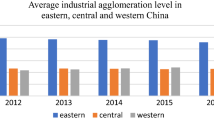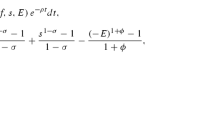Abstract
The fiscal decentralization system under China’s political centralization affects local economic and environmental policies, and thus has an important impact on environmental quality. This paper uses the panel data of 285 cities in China from 2003 to 2018 and the spatial Durbin model to empirically analyze the impact of fiscal decentralization on haze pollution and its mechanism. The results show that the increase in fiscal decentralization will significantly aggravate the haze pollution in and around the region, and this conclusion is still valid after a series of robustness tests. Moreover, the impact of fiscal decentralization on haze pollution has significant heterogeneity in the size and region of the city, and the sample period. In addition, mechanism analyses show that fiscal decentralization has aggravated haze pollution by increasing infrastructure construction, reducing environmental regulations, and intensifying market segmentation. Further analyses reveal that, on the one hand, local governments have the ability to control haze pollution in their own regions according to their own wishes and interests, but on the other hand, adjustments to environmental policies in surrounding areas will significantly inhibit the control of environmental policies in the region, thereby making local governments haze pollution has not been effectively controlled. This is essentially a “Race to bottom” phenomenon among local governments in environmental policies.
Similar content being viewed by others
Data Availability
Not applicable.
Notes
Bijie, Tongren, Chaohu, Sansha, and Haidong were not included in the analysis due to administrative division adjustment, and Lhasa was not included in the analysis due to incomplete data.
Both the null hypothesis H0 : θ = 0 and H0 : θ + δβ = 0 are expressed relative to the basic form of the spatial Durbin model. The specific model is as follows:
$$ \kern2.5em Y=\rho WY+\alpha {l}_N+ X\beta + WX\theta +\varepsilon $$$$ \kern2.5em \upvarepsilon \sim \mathrm{N}\left(0,{\sigma}^2{I}_n\right) $$When θ = 0, the spatial Durbin model is simplified to the spatial lag model.
When θ + δβ = 0, the spatial Durbin model is simplified to a spatial error model.
References
Atasoy BS (2017) Testing the environmental Kuznets curve hypothesis across the U.S.: Evidence from panel mean group estimators. Renew Sust Energ Rev 77:731–747
Cheng ZH, Li LS, Liu J (2017) Identifying the spatial effects and driving factors of urban PM2.5 pollution in China. Ecol Indic 82:61–75
Cheng ZH, Li LS, Liu J (2018a) Industrial structure, technical progress and carbon intensity in China’s provinces. Renew Sust Energ Rev 81:2935–2946
Cheng ZH, Li LS, Liu J (2018b) The spatial correlation and interaction between environmental regulation and foreign direct investment. J Regul Econ 54(2):124–146
Chupp BA (2011) Environmental constituent interest, green electricity polices, and legislative voting. J Environ Econ Manag 62:254–266
Dietz T, Rosa E A (1994) Rethinking the environmental impacts of population, affluence and technology. Human Ecology Review 2:277–300
Dijkstra BR, Fredriksson PG (2010) Regulatory environmental federalism. Ann Rev Resour Econ 2(1):319–339
Ehrlich P R, Holdren J P (1971) Impacts of population growth. Science 7:1212–1217
Elhorst JP (2010) Spatial panel data models. In Handbook of applied spatial analysis. M M Fischer, A Getis. 377-407. Berlin: Springer.
Elhorst JP (2014) Matlab software for spatial panels. Int Reg Sci Rev 37(3):389–405
Fredriksson PG, List JA, Millimet DL, (2003) Bureaucratic corruption, environmental policy and inbound US FDI: theory and evidence. Journal of Public Economics,87(7-8).
Gill AR, Viswanathan KK, Hassan S (2018) The Environmental Kuznets Curve (EKC) and the environmental problem of the day. Renew Sust Energ Rev 81:1636–1642
Hao Y, Chen YF, Liao H, Wei YM (2019) China’s fiscal decentralization and environmental quality: theory and an empirical study. Environ Dev Econ:1–23
He QC (2015) Fiscal decentralization and environmental pollution: evidence from Chinese panel data. China Econ Rev 36:86–100
Holmstrom B, Milgrom P (1991) Multi-task principal-agent analyses: incentive contracts, asset ownership and job design. Journal of Law, Economics and. Organization 7:24–52
Hu H, Xie N, Fang DB, Zhang XL (2018) The role of renewable energy consumption and commercial services trade in carbon dioxide reduction: Evidence from 25 developing countries. Appl Energy 211:1229–1244
Huang SF (2017) A study of impacts of fiscal decentralization on smog pollution. World Econ 2:127–152
Kamp DVD, Lorentzen P, Mattingly D (2017) Racing to the bottom or to the top? Decentralization, Revenue pressures, and governance reform in China. World Dev 95:164–176
Kang ZY, Li K, Qu JY (2018) The path of technological progress for China’s low-carbon development: evidence from three urban agglomerations. J Clean Prod 178:644–654
Kuai P, Yang S, Tao A, Zhang S', Khan ZD (2019) Environmental effects of Chinese-style fiscal decentralization and the sustainability implications. J Clean Prod 239:118089
Kunce M, Shogren J (2005) On interjurisdictional competition and environmental federalism. J Environ Econ Manag 50:212–224
Kunce M, Shogren J (2007) Destructive interjurisdictional competition: Firm, capital and labor mobility in a model of direct emission control. Ecol Econ 60(3):543–549
Lee LF, Yu JH (2010a) A spatial dynamic panel data model with both time and individual fixed effects. Econometric Theory 26(2):564–597
Lee LF, Yu JH (2010b) Some recent developments in spatial panel data models. Reg Sci Urban Econ 40(5):255–271
Lesage JP, Fischer MM (2008) Spatial growth regressions. Model specification, estimation and interpretation. Spat Econ Anal 3(3):1742–1870
LeSage JP, Pace RK (2009) Introduction to spatial econometrics. Boca Raton, US: CRC Press Taylor & Francis Group. 54-73.
Levinson A (2003) Environmental regulatory competition: a status report and some new evidence. Natl Tax J 56:91–106
Li L, Qian J, Ou CQ, Zhou YX, Guo C, Guo YM (2014) Spatial and temporal analysis of Air Pollution Index and its timescale-dependent relationship with meteorological factors in Guangzhou, China, 2001-2011. Environ Pollut 190:75–81
Li AJ, Zhang AZ, Zhou YZ, Yao X (2017) Decomposition analysis of factors affecting carbon dioxide emissions across provinces in China. J Clean Prod 141:1428–1444
Liang X, Zou T, Guo B (2015) Assessing Beijing’s PM2.5 pollution: severity, weather impact, APEC and winter heating. Proceedings of the Royal Society A: Mathematical, Physical and Engineering Science 471:20150257
Liddle B (2018) Consumption-based accounting and the trade-carbon emissions nexus. Energy Econ 69:71–78
Lipscomb M, Mobarak AM (2017) Decentralization and pollution spillovers: evidence from the re-drawing of country borders in Brazil. Rev Econ Stud 84:464–502
Ma YR, Q J, Fan Y (2016) Spatial linkage analysis of the impact of regional economic activities on PM2.5 pollution in China. J Clean Prod 139:1157–1167
Meliciani V, Savona M (2015) The determinants of regional specialization in business services: agglomeration economics, vertical linkages and innovation. J Econ Geogr 15:387–416
Mintz J, Tulkens H (1986) Commodity tax competition between member states of a federation: equilibrium and efficiency. J Public Econ 29(2):133–172
Mohammad MR, Khosrul A (2021) Clean energy, population density, urbanization and environmental pollution nexus: evidence from Bangladesh. Renew Energy 03:103
Oates WE (2001) A reconsideration of environmental federalism. Resources For the Future, Discussion Papers dp-01-54.
Oates WE, Portney PR (2003) The political economy of environmental policy. Handbook of environmental economics. Elsevier,325-354.
Oates WE, Schwab R (1988) Economic competition among jurisdictions: efficiency enhancing or distortion inducing? J Public Econ 35(3):333–354
Poncet S (2003) Measuring Chinese domestic and international integration. China Econ Rev 14(1):1–21
Qian YY, Roland G (1998) Federalism and the soft budget constrain. Am Econ Rev 88(5):1143–1162
Que W, Zhang YB, Liu SB, Yang CP (2018) The spatial effect of fiscal decentration and factor market segmentation on environmental pollution. J Clean Prod 184:402–413
Ran QY, Zhang JN, Hao Y (2020) Does environmental decentralization exacerbate China’s carbon emissions? Evidence based on dynamic threshold effect analysis. Sci Total Environ 721:137656
Shen JY, Zhao QB, Cheng Z et al (2020) Insights into source origins and formation mechanisms of nitrate during winter haze episodes in the Yangtze River Delta. Sci Total Environ 741:140187
Sheng PF, Guo XH (2016) The long-run and short-run impacts of urbanization on carbon dioxide emissions. Econ Model 53:208–215
Sigman H (2005) Transboundary spillovers and decentralization of environmental policies. J Environ Econ Manag 50(1):82–101
Sigman H (2014) Decentralization and environmental quality: an international analysis of water pollution levels and variation. Land Econ 90(1):114–130
Su B, Ang BW, Li YZ (2017) Input-output and structural decomposition analysis of Singapore’s carbon emissions. Energy Policy 105:484–492
Sun Z, Chang CP, Hao Y (2017) Fiscal decentration and China’s provincial economic growth: a panel data analysis for China’s tax sharing system. Qual Quant 51:2267–2289
Tiebout C (1956) A pure theory of local expenditures. J Polit Econ 64(5):416–424
Ulph A (2000) Harmonization and optimal environmental policy in a federal system with asymmetric information. Journal of Environmental Economics and Mangement 29(2):224–241
van Donkelaar A, Martin RV, Brauer M, Hsu NC, Kahn RA, Levy RC, Lyapustin A, Sayer AM, Winker DM (2016) Global estimates of fine particulate matter using a combined geophysical-statistical method with information from satellites. Environ Sci Technol 50(7):3762–3772
Wei Q, Zhang YB, Liu SB, Yang CP (2018) The spatial effect of fiscal decentralization and factor market segmentation on environmental pollution. J Clean Prod 184:402–413
Wellisch D (1995) Locational choices of firms and decentralized environmental policy with various instruments. J Urban Econ 37(3):290–310
Wen W, Ma X, Tang YX, Wei P, Wang JK, Guo CW (2020) The impacts of meteorology on source contributions of air pollution in winter in Beijing, 2015–2017 changes. Atmospheric Pollution Research 11:1953–1962
Wildasin D (1988) Nash equilibrium in models of fiscal competition. J Public Econ 35(2):229–240
Wilson LS (1996) Capital mobility and environmental standards: is there a race to the bottom? In: Harmonization and Fair Trade. MIT Press, Cambridge, MA, pp 395–427
Xu B, Lin BQ (2018) What cause large regional differences in PM2.5 pollutions in China? Evidence from quantile regression model. J Clean Prod 174:447–461
Yan FH, Cheng WH, Jia SG et al (2020) Stabilization for the secondary species contribution to PM2.5 in the Pearl River Delta (PRD) over the past decade, China: a meta-analysis. Atmos Environ 242:117817
Yu JF, Jong RD, Lee LF (2008) Quasi-maximum likelihood estimators for spatial dynamic panel data with fixed effects when both N and T are large. J Econ 146(1):118–134
Yu S W, Zheng S H, Li X, Li L X. China can peak its energy-related carbon emissions before 2025: Evidence from industry restructuring. Energy Econ, 2018 73 :91-107.
Zhang K, Zhang ZY, Liang QM (2017a) An empirical analysis of the green paradox in China: from the perspective of fiscal decentralization. Energy Policy 103:203–211
Zhang N, Yu KR, Chen ZF (2017b) How does urbanization affect carbon dioxide emissions? A cross-country panel data analysis. Energy Policy 107:678–687
Zhang B, Chen XL, Guo HX (2018) Does central supervision enhance local environmental enforcement? Quasi-experimental evidence from China. J Public Econ 164:70–90
Zhou LA, Wu M (2015) Tax sharing rates among sub-provincial governments in China: facts and explanation. Financial Research 10:64–80
Zhu L, Gan QM, Liu Y, Yan ZJ (2017) The impact of foreign direct investment on SO2 emissions in the Beijing-Tianjin-Hebei region: a spatial econometric analysis. J Clean Prod 166:189–196
Funding
This paper was supported by the National Natural Foundation of China (71803087).
Author information
Authors and Affiliations
Contributions
Zhonghua Cheng: conceptualization; formal analysis; methodology; writing-original draft.
Yeman Zhu: formal analysis; writing-review and editing; software.
Corresponding author
Ethics declarations
Consent to participate
Not applicable.
Consent for publication
Not applicable.
Competing interests
The authors declare no competing interests.
Additional information
Responsible Editor: Ilhan Ozturk
Publisher’s note
Springer Nature remains neutral with regard to jurisdictional claims in published maps and institutional affiliations.
Rights and permissions
About this article
Cite this article
Cheng, Z., Zhu, Y. The spatial effect of fiscal decentralization on haze pollution in China. Environ Sci Pollut Res 28, 49774–49787 (2021). https://doi.org/10.1007/s11356-021-14176-y
Received:
Accepted:
Published:
Issue Date:
DOI: https://doi.org/10.1007/s11356-021-14176-y




